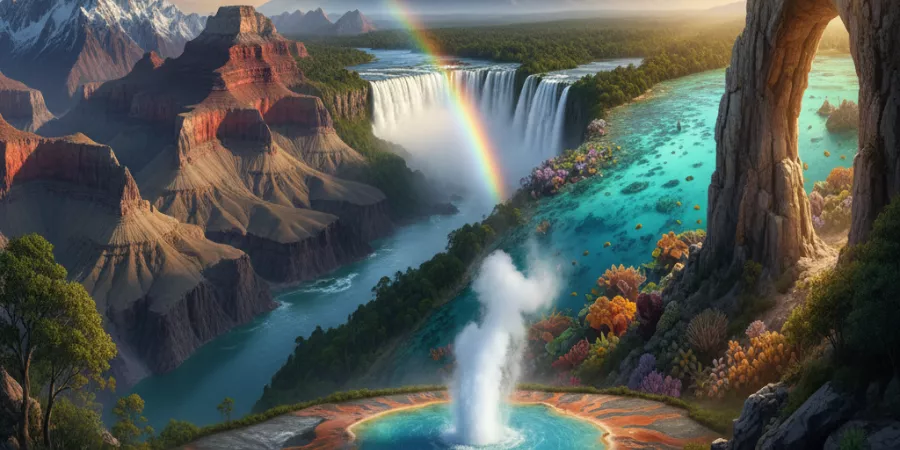The Earth is a masterpiece of nature, adorned with breathtaking landscapes and awe-inspiring formations. Across continents and oceans, nature has sculpted wonders that captivate the imagination, drawing travelers and explorers alike. From towering peaks to mesmerizing water bodies, here are some of the most iconic natural wonders that define the beauty of our planet.
Iconic Natural Wonders:
1. The Grand Canyon, USA
One of the most recognizable natural landmarks, the Grand Canyon in Arizona is a geological marvel. Carved by the Colorado River over millions of years, its layered rock formations tell the story of Earth’s history. Stretching approximately 277 miles long and over a mile deep, the canyon offers breathtaking vistas, especially at sunrise and sunset, making it a bucket-list destination for adventurers.
2. Mount Everest, Nepal/Tibet
As the highest peak on Earth, Mount Everest stands at a staggering 29,032 feet (8,849 meters) above sea level. Part of the Himalayas, this towering giant has fascinated climbers and mountaineers for centuries. Despite its treacherous conditions, it remains an ultimate goal for those seeking to conquer nature’s most formidable challenge.
3. The Great Barrier Reef, Australia
The world’s largest coral reef system, the Great Barrier Reef stretches over 1,400 miles along Australia’s northeast coast. Home to thousands of marine species, vibrant coral formations, and crystal-clear waters, it is a paradise for divers and snorkelers. Climate change poses a significant threat to this delicate ecosystem, making conservation efforts more crucial than ever.
4. Victoria Falls, Zambia/Zimbabwe
Dubbed “The Smoke That Thunders,” Victoria Falls is one of the largest and most powerful waterfalls on Earth. Spanning over a mile wide and dropping 355 feet, the falls create a mist that can be seen from miles away. The thunderous roar and sheer force of the water make it an unforgettable sight and a must-visit for nature lovers.
5. The Amazon Rainforest, South America
Covering nearly 40% of South America, the Amazon Rainforest is often called the “lungs of the Earth” due to its vast biodiversity and role in producing oxygen. It houses an estimated 10% of all known species, from jaguars to vibrant macaws. However, deforestation poses a significant threat to this natural wonder, emphasizing the need for sustainable conservation.
6. The Northern Lights, Arctic Circle
The Aurora Borealis, or Northern Lights, is a celestial phenomenon that illuminates the polar skies with vibrant hues of green, pink, and purple. Best viewed in regions like Norway, Canada, and Iceland, these magical lights result from charged particles from the sun colliding with Earth’s atmosphere. A winter spectacle like no other, the Northern Lights continue to amaze those lucky enough to witness them.
7. Parícutin Volcano, Mexico
Unlike most volcanoes, Parícutin is one of the few whose birth was witnessed by humans. In 1943, a Mexican farmer saw the ground crack and spew lava, eventually forming this cinder cone volcano. Today, it stands as a testament to the ever-changing nature of our planet and remains a significant geological wonder.
8. Ha Long Bay, Vietnam
Famed for its emerald waters and towering limestone islands, Ha Long Bay is a UNESCO World Heritage Site and a jewel of Vietnam. The bay features thousands of karst formations shaped over millions of years, creating a surreal seascape that draws visitors from around the world.
9. The Sahara Desert, Africa
The largest hot desert on Earth, the Sahara covers vast portions of North Africa. Its endless sand dunes, stretching as far as the eye can see, create a landscape of mesmerizing beauty. Despite its harsh conditions, the desert is home to resilient wildlife and nomadic cultures that have adapted to its extremes.
10. Iguazu Falls, Argentina/Brazil
Straddling the border of Argentina and Brazil, Iguazu Falls is a collection of over 275 waterfalls cascading through a subtropical rainforest. The sheer volume of water and the lush greenery surrounding the falls make it one of the most spectacular sights in the world.
Preserving Our Natural Wonders
These natural wonders are more than just scenic marvels—they are vital to our planet’s ecosystem and cultural heritage. Many of these wonders face threats from climate change, pollution, and human activities. Conservation efforts and sustainable tourism are essential to ensure that future generations can continue to experience their magnificence.
Nature’s grandeur reminds us of the planet’s sheer power and beauty. Whether through towering peaks, sprawling deserts, or vibrant reefs, these wonders inspire us to cherish and protect the incredible world we call home.






